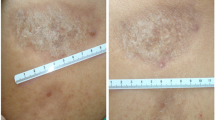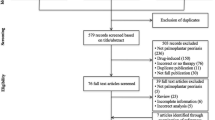Abstract
Background: Tacrolimus, a calcineurin inhibitor, is an immunomodulating and anti-inflammatory drug that inhibits T-cell activation and production of cytokines. The elevated level of cytokines in morphea causes fibroblast proliferation and subsequent overproduction of collagen. Theoretically, tacrolimus could inhibit the pathophysiologic process of morphea.
Objective: To assess whether tacrolimus 0.1% ointment is an effective treatment for active plaque morphea in a double-blind, placebo (petroleum emollient)-controlled pilot study.
Methods: Ten patients with active plaque morphea were included. All patients were treated with tacrolimus 0.1% ointment and with an emollient (petrolatum) on two selected morphea plaques, applied twice daily for 12 weeks. Initial and final assessment included surface area measurements, photography, durometer scores, and clinical feature scores. Adverse reactions were recorded.
Results: The scleroderma plaques treated with topical tacrolimus 0.1% improved, resulting in a significant reduction in durometer and clinical feature scores. Overall, a significant difference could be found between topical tacrolimus and petrolatum with regard to durometer score (p < 0.005) and the clinical feature score (p = 0.019).
Conclusion: In this first double-blind, placebo-controlled pilot study comparing tacrolimus 0.1% ointment with petrolatum in active plaque morphea, tacrolimus 0.1% ointment was shown to be an effective treatment for this condition.




Similar content being viewed by others
References
Assmann T, Homey B, Ruzicka T. Applications of tacrolimus for the treatment of skin disorders. Immunopharmacology 2000; 47: 203–13
Zulian F. Systemic manifestations in localized scleroderma. Curr Rheumatol Rep 2004; 6: 417–24
Alecu M, Geleriu L, Coman G, et al. The interleukin-1, interleukin-2, interleukin-6 and tumour necrosis factor alpha serological levels in localised and systemic sclerosis. Rom J Intern Med 1998; 36: 251–9
Hasegawa M, Sato S, Nagaoka T, et al. Serum levels of tumor necrosis factor and interleukin-13 are elevated in patients with localized scleroderma. Dermatology 2003; 207: 141–7
Ihn H, Sato S, Fujimoto M, et al. Demonstration of interleukin 8 in serum samples of patients with localized scleroderma. Arch Dermatol 1994; 130: 1327–8
Ihn H, Sato S, Fujimoto M, et al. Demonstration of interleukin-2, interleukin-4 and interleukin-6 in sera from patients with localized scleroderma. Arch Dermatol Res 1995; 287: 193–7
Chung L, Lin J, Furst DE, et al. Systemic and localized scleroderma. Clin Dermatol 2006; 24: 374–92
Peterson LS, Nelson AM, Su WP. Classification of morphea (localized scleroderma). Mayo Clin Proc 1995; 70: 1068–76
Joly P, Bamberger N, Crickx B, et al. Treatment of severe forms of localized scleroderma with oral corticosteroids: follow-up study on 17 patients. Arch Dermatol 1994; 130: 663–4
Dytoc M, Ting PT, Man J, et al. First case series on the use of imiquimod for morphoea. Br J Dermatol 2005; 153: 815–20
Aragane Y, Kawada A, Maeda A, et al. Disseminated scleroderma of a Japanese patient successfully treated with bath PUVA photochemotherapy. J Cutan Med Surg 2001; 5: 135–9
Kreuter A, Gambichler T, Breuckmann F, et al. Pulsed high-dose corticosteroids combined with low-dose methotrexate in severe localized scleroderma. Arch Dermatol 2005; 141: 847–52
Seyger MM, van Den Hoogen FH, de Boo T, et al. Low-dose methotrexate in the treatment of widespread morphea. J Am Acad Dermatol 1998; 39: 220–5
Uziel Y, Feldman BM, Krafchik BR, et al. Methotrexate and corticosteroid therapy for pediatric localized scleroderma. J Pediatr 2000; 136: 91–5
Falanga V, Medsger Jr TA. D-penicillamine in the treatment of localized scleroderma. Arch Dermatol 1990; 126: 609–12
Hunzelmann N, Anders S, Fierlbeck G, et al. Double-blind, placebocontrolled study of intralesional interferon gamma for the treatment of localized scleroderma. J Am Acad Dermatol 1997; 36: 433–5
Kreuter A, Hyun J, Stucker M, et al. A randomized controlled study of low-dose UVA1, medium-dose UVA1, and narrowband UVB phototherapy in the treatment of localized scleroderma. J Am Acad Dermatol 2006; 54: 440–7
Mancuso G, Berdondini RM. Topical tacrolimus in the treatment of localized scleroderma. Eur J Dermatol 2003; 13: 590–2
Mancuso G, Berdondini RM. Localized scleroderma: response to occlusive treatment with tacrolimus ointment. Br J Dermatol 2005; 152: 180–2
Walker JG, Pope J, Baron M, et al. The development of systemic sclerosis classification criteria. Clin Rheumatol 2007; 26: 1401–9
Tuffanelli DL. Localized scleroderma. Semin Cutan Med Surg 1998; 17: 27–33
Zachariae H, Bjerring P, Halkier-Sorensen L, et al. Skin scoring in systemic sclerosis: a modification. Relations to subtypes and the aminoterminal propeptide of type III procollagen (PIIINP). Acta Derm Venereol 1994; 74: 444–6
Kissin EY, Schiller AM, Gelbard RB, et al. Durometry for the assessment of skin disease in systemic sclerosis. Arthritis Rheum 2006; 55: 603–9
Seyger MM, van den Hoogen FH, de Boo T, et al. Reliability of twomethods to assess morphea: skin scoring and the use of a durometer. J Am Acad Dermatol 1997; 37: 793–6
Zulian F, Meneghesso D, Grisan E, et al. A new computerized method for the assessment of skin lesions in localized scleroderma. Rheumatology (Oxford) 2007; 46: 856–60
Goto T, Kino T, Hatanaka H, et al. Discovery of FK-506, a novel immunosuppressant isolated from Streptomyces tsukubaensis. Transplant Proc 1987; 19: 4–8
Brune A, Miller DW, Lin P, et al. Tacrolimus ointment is effective for psoriasis on the face and intertriginous areas in pediatric patients. Pediatr Dermatol 2007; 24: 76–80
Simpson D, Noble S. Tacrolimus ointment: a review of its use in atopic dermatitis and its clinical potential in other inflammatory skin conditions. Drugs 2005; 65: 827–58
Rustin MH. The safety of tacrolimus ointment for the treatment of atopic dermatitis: a review. Br J Dermatol 2007; 157: 861–73
Bohm M, Frieling U, Luger TA, et al. Successful treatment of anogenital lichen sclerosus with topical tacrolimus. Arch Dermatol 2003; 139: 922–4
Matsumoto Y, Yamamoto T, Isobe T, et al. Successful treatment of vulvar lichen sclerosus in a child with low-concentration topical tacrolimus ointment. J Dermatol 2007; 34: 114–6
Virgili A, Lauriola MM, Mantovani L, et al. Vulvar lichen sclerosus: 11 women treated with tacrolimus 0.1% ointment. Acta Derm Venereol 2007; 87: 69–72
Hawk A, English III JC. Localized and systemic scleroderma. Semin Cutan Med Surg 2001; 20: 27–37
Robinson N, Singri P, Gordon KB. Safety of the new macrolide immunomodulators. Semin Cutan Med Surg 2001; 20: 242–9
Kikuchi K, Tagami H. Comparison of the effects of daily applications between topical corticosteroid and tacrolimus ointments on normal skin: evaluation with noninvasive methods. Dermatology 2002; 205: 378–82
Kyllönen H, Remitz A, Mandelin JM, et al. Effects of 1-year intermittent treatment with topical tacrolimus monotherapy on skin collagen synthesis in patients with atopic dermatitis. Br J Dermatol 2004; 150: 1174–81
Reitamo S, Rissanen J, Remitz A, et al. Tacrolimus ointment does not affect collagen synthesis: results of a single-center randomized trial. J Invest Dermatol 1998; 111: 396–8
Acknowledgments
No sources of funding were used to assist in the preparation of this study. The authors have no conflicts of interest that are directly relevant to the content of this study.
Author information
Authors and Affiliations
Corresponding author
Rights and permissions
About this article
Cite this article
Kroft, E.B., Groeneveld, T.J., Seyger, M.M. et al. Efficacy of Topical Tacrolimus 0.1% in Active Plaque Morphea. Am J Clin Dermatol 10, 181–187 (2009). https://doi.org/10.2165/00128071-200910030-00004
Published:
Issue Date:
DOI: https://doi.org/10.2165/00128071-200910030-00004




